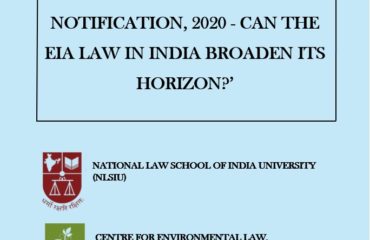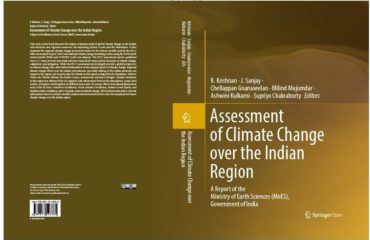S.L.P. (C) NOS.9036-9038 OF 2016) decided on 6th March, 2020; 2020 SCC OnLine SC 316
This case was adjudicated by a five-judge bench of the Supreme Court, constituted by the CJI to clarify the interpretation of Section 24(2) of the Land Acquisition Act, 2013. The provision had been interpreted in Pune Municipal Corporation v. Harakchand Solanki, decided by a three-judge bench of the Supreme Court. However, the position of law laid down in this case was doubted in Yogesh Neema v. State of MP, decided by a two-judge bench of the Court.[1]Further, by a majority of 2:1, the Court in Indore Development Authority v Shailendra (dead) through Legal Representatives provided a different interpretation. Further, in the latter case, the Court held the judgment in Pune Municipal Corporation as per incuriam, for not considering several pertinent aspects.[2] A couple of other judgments also doubted the position in this case, and referred the matter to the CJI. Hence, the judgment in Indore Development Authority was referred to a larger bench, and was heard by a five-judge Constitution bench headed by Justice Arun Mishra.
Section 114 of the Land Acquisition Act, 2013 provides for the repeal ofLand Acquisition Act, 1894. As per Section 114(2), the effect of the repeal is governed by the provisions of Section 6 of the General Clauses Act, save as otherwise provided in the Act. The effect of Section 6 is that the repeal cannot revive or affect any proceedings/ rights/ liabilities/ punishments conducted/ accrued before the repeal. Further, any investigations or proceedings instituted under the previous laws may be continued or enforced under the same.
Section 24 is one provision in the Act that provides for a deviation from Section 6 of the GCA. It deals with some of the proceedings instituted before, and continuing when, the Land Acquisition Act came into force. It hence deals with the retrospective application of the statute to proceedings started before the commencement of the Act. It starts with a non-obstante clause, hence providing it with an overriding effect over Section 114. The clauses of Sections 24(1) envisage two situations concerning proceedings pending at the time of commencement of the 2013 Act: where the award under Section 11 of the 1894 Act was not made, and those in which the same was made. When the former is the case, the effect is not a lapse of proceedings: only the provisions of the 2013 Act relating to the determination of compensation shall apply.[3]In the latter situation, the provisions of the 1894 Act are to apply in toto, and there is no retrospective application of the 2013 Act.[4]
It was the contours of Section 24(2) that were under consideration in the present case. While there was a total of six legal issues framed and adjudicated by the Court, relating to different phrases and aspects of this provision, three of them are pertinent for an analysis of the Court’s view of retrospectivity.
Section 24(2) provides for certain conditions on the fulfilment of which the retrospective effect of the current Act on ongoing proceedings would be such that the proceedings concerned would lapse completely. The same starts with a non-obstante clause to 24(1), effectively operating as a non-obstante clause to 24(1)(b), since both contemplate a situation where the award has been made (while Section 24(1)(a) does not contemplate such a situation).[5]There are three conditions mentioned in 24(2) for the lapse of proceedings: when (a) the award was made more than, or equal to, five years before the commencement of the 2013 Act (b) the physical possession of the land has not been taken (c) the compensation for the acquisition has not been paid.
It is settled that the first condition is a mandatory one for Section 24(2) to be applicable. However, it was the interpretation of the relationship between conditions (b) and (c) that was a primary legal issue in this case. In the statute, these conditions are linked with the conjunction ‘or’. The legal issue was whether these conditions are alternatives, with the fulfilment of either one leading to a lapse, or whether these are both necessary conditions for the lapse (and hence the ‘or’ should be interpreted as a ‘nor’/‘and’) (the second legal issue in the case). While the State argued for the latter interpretation, the landlords argued for the former to be adopted.
Secondly, the Court had to decide meaning of ‘paid’ as used in the main clause of 24(2), as well as that of ‘deposited’ in the proviso (the first legal issue in this case). One of the arguments made by the Court for its interpretation relates to retrospectivity, and is hence relevant.
Further, the Court also adjudicated on the scope of 24(2), in terms of the proceedings covered under the same. The Court noted that the provision was being invoked to challenge acquisition proceedings that had long concluded. It hence examined whether time-barred, stale, or concluded proceedings could be challenged under this provision (the sixth legal issue in the case).
All of these issues were, in different ways, issues relating to the retrospective application of the statute. The second legal issue was linked to retrospectivity as the Court’s interpretation of whether the mentioned conditions were cumulative would influence the degree of retrospectivity of the 2013 Act, by determining which existing proceedings would be deemed lapsed. The sixth legal issue was linked to retrospectivity as it concerned the application of the statute to matters that had been settled as per the previous statute, or were time barred.
Needless to say, the principles of statutory interpretation relating to the retrospective effect of the statute formed an integral part of the Court’s reasoning with respect to the second legal issue. The Court cited Bennion’s Statutory interpretation, which avers that there is a general presumption against retrospective application of a statute. Such a presumption can be rebutted if the retrospective operation was intended by the legislature, but even in such cases the operation should be confined to as narrow a compass as is required by the legislative intent.[6]Further, the legislature is presumed not to have allowed retrospective operation in a manner unfair to those affected by the same: so unless a contrary intention appears, such an interpretation is presumed not to be tenable.[7]
The Court then cites various case laws, Indian and British, that lay down congruent principles relating to retrospectivity. These principles are-
- The principle relating to non-retrospectivity is not confined to criminal law, it is a prima facie rule of statutory construction. Hence, if the language of the enactment is capable of both prospective and retrospective application, the statute ought to be construed prospectively;[8]
- There should be no greater retrospective operation than the language of the provision renders necessary (Lauri v. Renad). Hence, a retrospective effect should either be provided for expressly or be the necessary and distinct implication of the statute;[9]
- Retrospectivity may be a matter of degree: the greater the unfairness caused by a retrospective application, the higher is the expectation from Parliament to specify that a retrospective effect is intended;[10]
- In determination of whether a provision has a retrospective effect, the language and object of the provision must be considered;[11]
- The Court also has to consider the effect of a retrospective application on the existing rights and obligations under the statute;[12]
- For retrospectivity to be constitutionally permissible, the same must be reasonable and not excessive and harsh[13] (in Commissioner of Income Tax v. Sarkar Builders, a retrospective application was rejected as the Court held it to be ‘absurd’ for an assessee to comply with a condition that was not initially part of the statute when the event took place);
- In the determination of retrospectivity, these factors are also relevant: (i) the general scope and purview of the statute (ii) the remedy sought to be applied (iii) the former state of the law (iv) the exact intention of the legislature[14]
These principles relating to retrospectivity played an integral part in the Court’s interpretation of the two conditions as cumulative. The Court noted that Section 24(2) provided for a complete lapse of proceedings in certain cases: hence, it had to be construed in conformity with the legislative intent, and Sections 114 of the 2013 Act and Section 6 of the GCA.[15] The Court sought to determine the extent to which the Act protected, and sought to take away, the rights of the parties concerned.
With respect to the object of the legislature, the Court held that the object was to provide for a lapse of proceedings only when both conditions (b) and (c) were fulfilled.[16] In the determination of the same, the Court considered the legislative history of the provision. The 2011 draft of the Bill had provided for the non-taking of possession, and the non-issue of award under Section 11, as independent sufficient conditions for the lapse of existing proceedings. However, Section 24 was amended to its present form after the Committee which had perused the bill recommended these amendments, arguing that there would be much time and cost overrun in many projects if lapsing of existing proceedings was allowed easily.[17] Further, during the Parliamentary debates on Section 24, the Minister concerned clarified that there would be a lapse of proceedings only when possession would not be taken and compensation would not be paid.[18]Based on the legislative history and the Statement of the minister, the Court concluded that the legislative intent was to make the conditions cumulative, and not disjunctive.
Hence, the Court held that Section 24(2) undoubtedly allowed retrospective application, and a lapse of proceedings, only when both the conditions are not followed, and the proceedings are kept pending because of the lethargy and inaction of the administration. This interpretation was held by the Court to be in conformity with the legislative intent.
These principles regarding retrospectivity also influenced the Court’s interpretation of the word ‘paid’ in 24(2). The Court held that the amount was ‘paid’ under this provision the moment it was offered, and deposition of the amount in Court was not a precondition for the amount to be ‘paid’. One of the reasons tendered for this interpretation was that in neither the 1894 Act nor the Act of 2013 was the non-deposition of the compensation amount a ground for the lapse of the proceedings. Under both the Acts, non-payment of the amount/ lack of deposition in Court was, and remains, grounds for only an interest on the amount. An interpretation of 24(2) interpreting ‘paid’ as ‘deposited in Court’ would, on the other hand, make past proceedings lapsed even if compensation had been offered, but not yet deposited in Court. Such as interpretation would, as per the Court, lead to a retrospective application of a standard when it did not exist.[19]Hence, this interpretation had to be avoided.[20]
Finally, the Court’s approach to retrospective application was reflected in its approach to the sixth legal issue. The Court held that Section 24(2) only covered within its ambit proceedings that were still ongoing when the Act of 2013 came into force: it does not cover past settled transactions.[21] Further, it does not revive time-barred claims, and does not allow landlords to reopen settled proceedings by questioning the mode of taking possession/ mode of deposit in the treasury etc.[22]
To support its conclusion, the Court cited various cases such as Municipal Corporation of Greater Bombay v. Industrial Development Investment Co Pvt. Ltd., where the Court had held that inordinate delay in filing the writ petition against an acquisition proceeding was a ground for dismissal of the petition on grounds of laches.[23] Further, in State of Assam v. Bhaskar Jyoti Sarma, a similar proposition was laid down in the context of the Urban Land Ceiling and Regulation Act 1976, which was repealed in 1999.[24] In this case, on repeal, a transaction in which physical possession had been taken over in 1991 was challenged in 1999, on grounds that a notification under Section 10(5) of the Act had not been issued. The Court held that even if the petitioner could make a legitimate grievance, no matter what the gain in the ultimate analysis, such a petition had to be preferred within a ‘reasonable time’ of such dispossession. If the same was not done, the forcible takeover would acquire legitimacy by sheer lapse of time, and the person must be deemed to have waived his right.[25]
Hence, the Court’s interpretation of the permissible retrospective application has played a key role in the adjudication of different legal issues. In general, it has influenced the Court in taking a narrower interpretation of Section 24, where possible, to limit the retrospective effect to where expressly provided for/ necessarily implied. In deciding whether retrospective application is express/ a necessary implication, the Court has relied on the intention of the legislature, as well as the words of the statute. This approach is consistent with the judicial decisions cited by the Court.[1]Para 3.
[2]Id.
[3]Para 103.
[4]Id.
[5] Para 104.
[6]Para 172
[7]Id.; This proposition was also laid down in Yamashita Shinnihon Steamship Co Ltd. v. L’officeChefifenDes Phosphates, Para 175.
[8]Yamashita Steamship, Para176.
[9]Yamashita Steamship,Para176.
[10]Id. Para 175.
[11]Gloucester Union v. Woolwich Union, Para 177.
[12]KS Paripoornan v. State of Kerala, Para 179.
[13]Zile Singh v. State of Haryana, Para180.
[14]Id.
[15]Para 176.
[16]Para 171.
[17]Para 186.
[18]Para 186.
[19]Para 239.
[20] To support this argument, the Court has not cited any case law/ other authorities.
[21]Para 403.
[22]Id.
[23]Para 384.
[24]Para 378.
[25]Para 378.
The Court also cited State of TN v L Krishnan for this proposition of law, which held in another case of acquisition proceedings under the 1894 Act that claims made after 5 years would be barred by latches. Hence, the Court refused to go into the merits of the case. UP State Jal Nigam v Jaswant Singh, Para389 and Rabindranath Bose v Union of India, Para 389 were also cited.





[…] how much rybelsus […]
[…] online clomid […]
[…] viagra 25 mg generico […]
[…] 50mg viagra prices […]
[…] cialis website […]
[…] ginseng root for men’s daily vitality […]
[…] cialis online buy […]
[…] 50mg sildenafil […]
[…] sildenafil tab 25mg […]
[…] cialis for sale online […]
[…] generic cialis […]
[…] sildenafil 50 mg price […]
[…] 20mg generic cialis pill […]